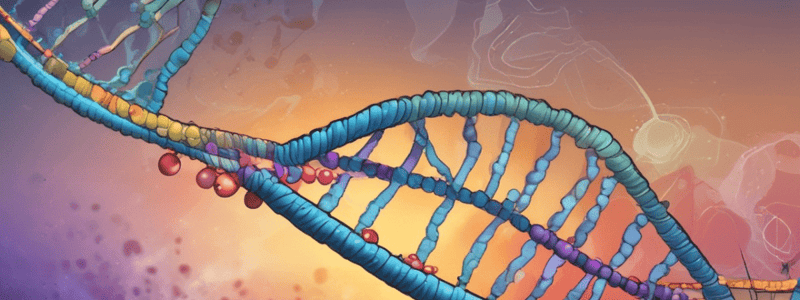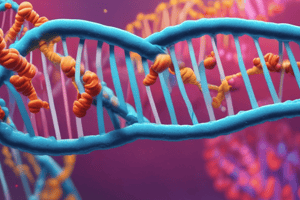Podcast
Questions and Answers
What is the function of DNA helicases in DNA replication?
What is the function of DNA helicases in DNA replication?
- To synthesize new DNA strands
- To bind tightly to single-stranded DNA
- To catalyze the formation of short hairpin helices
- To unwind the DNA double helix in front of the replication fork (correct)
In what direction can a DNA helicase unwind the DNA double helix?
In what direction can a DNA helicase unwind the DNA double helix?
- In either the 5′-to-3′ or 3′-to-5′ direction (correct)
- Only in the 5′-to-3′ direction
- Only in the 3′-to-5′ direction
- In a random direction
What is the role of single-strand DNA-binding proteins (SSB) in DNA replication?
What is the role of single-strand DNA-binding proteins (SSB) in DNA replication?
- To synthesize new DNA strands
- To unwind the DNA double helix
- To catalyze the formation of short hairpin helices
- To bind tightly to single-stranded DNA and prevent hairpin helix formation (correct)
What is the consequence of not removing short hairpin helices on the lagging strand template?
What is the consequence of not removing short hairpin helices on the lagging strand template?
What is the characteristic of DNA polymerase molecules during DNA synthesis?
What is the characteristic of DNA polymerase molecules during DNA synthesis?
What is the speed of DNA helicase movement along a single DNA strand?
What is the speed of DNA helicase movement along a single DNA strand?
What is the energy source for DNA helicase activity?
What is the energy source for DNA helicase activity?
What is the result of DNA helicase binding to single strands of DNA?
What is the result of DNA helicase binding to single strands of DNA?
What is the primary function of DNA polymerase during DNA replication?
What is the primary function of DNA polymerase during DNA replication?
What is the purpose of the conformational change in DNA polymerase during DNA replication?
What is the purpose of the conformational change in DNA polymerase during DNA replication?
What is the result of the accidental incorporation of ribonucleotides during DNA replication?
What is the result of the accidental incorporation of ribonucleotides during DNA replication?
What is the role of DNA topoisomerases during DNA replication?
What is the role of DNA topoisomerases during DNA replication?
What is the characteristic of the DNA replication fork?
What is the characteristic of the DNA replication fork?
What is the purpose of the strand-directed mismatch repair system?
What is the purpose of the strand-directed mismatch repair system?
What is the outcome of the high fidelity of DNA replication?
What is the outcome of the high fidelity of DNA replication?
What is the primary mechanism that ensures the high fidelity of DNA replication?
What is the primary mechanism that ensures the high fidelity of DNA replication?
What is the primary function of the PCNA protein in eukaryotes during DNA replication?
What is the primary function of the PCNA protein in eukaryotes during DNA replication?
How does the DNA polymerase on the lagging-strand template interact with the clamp during DNA replication?
How does the DNA polymerase on the lagging-strand template interact with the clamp during DNA replication?
What is the role of the clamp loader in the assembly of the clamp around the DNA?
What is the role of the clamp loader in the assembly of the clamp around the DNA?
What is the characteristic of the interaction between the DNA polymerase and the clamp on the leading strand?
What is the characteristic of the interaction between the DNA polymerase and the clamp on the leading strand?
What is the purpose of the clamp in DNA replication?
What is the purpose of the clamp in DNA replication?
What is the consequence of the DNA polymerase reaching the 5′ end of the preceding Okazaki fragment on the lagging strand?
What is the consequence of the DNA polymerase reaching the 5′ end of the preceding Okazaki fragment on the lagging strand?
What is the function of the clamp loader in the context of the lagging-strand polymerase?
What is the function of the clamp loader in the context of the lagging-strand polymerase?
What is the structural characteristic of the clamp protein that allows it to slide freely along the DNA?
What is the structural characteristic of the clamp protein that allows it to slide freely along the DNA?
What is the role of 3’ to 5’ proofreading exonuclease in DNA polymerase?
What is the role of 3’ to 5’ proofreading exonuclease in DNA polymerase?
Why is DNA polymerase unable to start DNA synthesis de novo?
Why is DNA polymerase unable to start DNA synthesis de novo?
What is the direction of DNA replication that allows for efficient error correction?
What is the direction of DNA replication that allows for efficient error correction?
What is the function of special proteins during DNA replication?
What is the function of special proteins during DNA replication?
What is the characteristic of the DNA double helix under physiological conditions?
What is the characteristic of the DNA double helix under physiological conditions?
What is the role of exonucleolytic proofreading during DNA replication?
What is the role of exonucleolytic proofreading during DNA replication?
What is the characteristic of DNA polymerase?
What is the characteristic of DNA polymerase?
What is synthesized by a special nucleotide-polymerizing enzyme?
What is synthesized by a special nucleotide-polymerizing enzyme?
What is the approximate rate of mutation in DNA replication?
What is the approximate rate of mutation in DNA replication?
Why is it necessary to maintain low mutation rates in DNA replication?
Why is it necessary to maintain low mutation rates in DNA replication?
What is the significance of maintaining accurate genetic instructions in DNA replication?
What is the significance of maintaining accurate genetic instructions in DNA replication?
Which type of cells must be protected against high rates of mutation?
Which type of cells must be protected against high rates of mutation?
What is the consequence of high mutation rates in somatic cells?
What is the consequence of high mutation rates in somatic cells?
What is the approximate size of the human genome?
What is the approximate size of the human genome?
Why is high fidelity in DNA replication necessary?
Why is high fidelity in DNA replication necessary?
What is the result of maintaining accurate genetic instructions in DNA replication?
What is the result of maintaining accurate genetic instructions in DNA replication?




